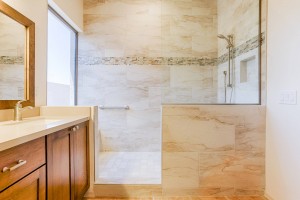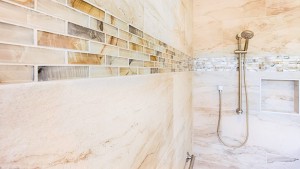

With the variety of flooring options on the market, homeowners may have a difficult time deciding on how to upgrade the floors in their homes. When it comes to choosing the right flooring material, consider the location, the moisture in the room and in your geographical location and the overall look and feel you want for your home.
Carpet
Carpet is a go-to flooring choice for many homeowners due to its reasonable cost, easy installation and a wide variety of design options. Carpet can be installed in a home in less than a day, and it needs less cleaning than other floor types. Professionals typically recommend vacuuming carpets at least once a week and steam cleaning once a year. Carpets generally last between 10 to 15 years. They work well in bedrooms and upstairs hallways as well as living rooms and family rooms. Homeowners can expect to pay between $3 and $5 per square foot.
Hardwood
Hardwood is a timeless flooring option, and tops the wish lists of many buyers. It can be purchased finished or unfinished. Finished flooring comes in a variety of stain colors. Unfinished flooring can be stained to your specific preference. It can be used in every room in your home except those below grade or where there are high levels of humidity. If it is cared for properly, it can last as long as your house. The cleaning for hardwood floors is more rigorous than that of carpet. Hardwood floors must be kept clean of dirt and debris, and spills must be cleaned promptly. Homeowners can expect to pay between $5 and $17 per square foot.
Engineered hardwood
Engineered hardwood is a layered hardwood product. The top layer is constructed of a thin sheet of hardwood. The bottom layers are comprised of plywood, fiberboard or additional layers of hardwood. The additional layers offer better moisture protection than that of hardwood, which means it is less susceptible to warping and buckling. Homeowners should look for high-quality engineered hardwood with a top layer that is thick enough to be sanded and refinished in the future. The cost of an engineered hardwood floor is comparable to that of hardwood with homeowners paying between $8 and $12 a square foot.
Laminate
Laminate flooring can be purchased as planks or tiles, and homeowners can choose styles that mimic wood or tile. The top layer is coated with a scratch and water-resistant coating, which means it can be installed in kitchens. If laminate is to be used in basements, it must be installed over a moisture barrier and all the edges must be glued and caulked to help prevent water damage. Laminate is usually not recommended for bathrooms. Homeowners can expect to pay between $1 and $5 per square foot, making it an affordable flooring option for those who want the look of wood or tile without the cost or maintenance.
Stone tile
Stone floors are extremely durable and once installed will most likely outlive your home. They can be used indoors and outdoors, giving you the ability to create flow from the interior of your home to your outdoor lounging areas. Stone tiles are available in marble, granite, limestone, travertine and slate. Manufacturers recommend sealing stone tiles to prevent water damage. Homeowners can expect to pay around $10 or more per square foot for stone tile.
Ceramic tile
Ceramic tile is a less expensive option when compared to stone. Homeowners can expect to pay between $7 and $9 per square foot, but tile can range from $2 per square foot to more than $40. Ceramic tile can be used in bathrooms and kitchens, and it comes in a wide-variety of styles and colors that can be mixed and matched to create custom designs.
When it comes to choosing the perfect flooring for your home, consider the cost, level of maintenance, durability and expected lifespan. If you plan to live in your home a while, it may be better to go with a more expensive option. If you plan to sell your home in the near future, choose an option that appeals to the majority of buyers.
About the author: Greg Geilman is a realtor and President and CEO of South Bay Residential in Manhattan Beach, Calif. Follow him on Twitter at @ggeilman.
We’ve written before about how remodeling a bathroom is a great return on investment and offered our tips, but we would be remiss in our duties if we didn’t pass on a few more we recently read about.
We came across a post called “Owner’s Guide To Bathroom Remodeling” by a Texas remodeling company and their advice is spot on.
First up, as with all remodeling projects, you need to clearly outline your goals. Do you want more space? A spa-like atmosphere? Sleek, clean spaces? More storage? Definite wow factor? Just universal improvement? Make sure you and your contractor are on the same page when it comes to goals.
Next, make sure everything goes together. Avoid the mix-and-match style. All parts of your bathroom must adopt a cohesive style or none of it will work. Again, getting on the same page with your designer is the best way to achieve your goals.
Also, know where to save money. You will save on costs if you minimally disturb the existing pipe and electrical structures. Letting that influence your design will save you money. Related, don’t be afraid to trust in your brand-name equipment. They enjoy their reputations for good reason, and those who offer a warranty will give you added peace of mind should anything happen down the road.
Speaking of bathroom remodels, one was included in a staggering renovation of a gutted London home. If you enjoy wild before-and-after photos, this slide show is for you.
The full on-makeover included an addition and a loft converted into a bedroom that will leave you slack-jawed.
Have a good week!
At MK Remodeling & Design, our passion is helping people realize their housing dreams.
Hand in hand with that passion is our joy in helping retrofit homes to allow seniors to live in worry-free comfort. That style of remodeling is called aging-in-place.
We stumbled across a New York Times article about the subject, titled “For old folks at home, remodeling is in order,” and it offers a comprehensive look at the motivations behind why many seniors are looking to remodel.
As the article points out, about 80 percent of older people own their homes, but less than four percent of all U.S. housing stock offers the most important features of home accessibility. This lopsided equation is the driving force behind many aging-in-place projects.
The projects outlined in the article range from the inexpensive (relocated outlets at around $100; two grab bars for around $200), to the moderate (tub conversion to roll-in shower for around $10,000), and the expensive (universal bathroom remodel for $25,000).
If this is all starting to sound familiar, you are totally on to us. We wrote about the subject not too long ago, but it bears repeating: Aging-in-place projects are driving remodeling spending.
So, hop aboard the aging-in-place remodeling train, and let us unlock your home’s potential!


